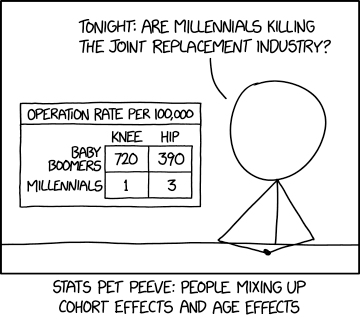December 3, 2018
#2080: Cohort and Age Effects explain

[Cueball as a news anchor is sitting at a desk with hands folded in front of him on the table.]
Cueball: Tonight: Are Millennials killing the joint replacement industry?
[To the left of Cueball is a presentation which includes a two by two table with a header above the table. Each of the two rows and columns are labeled, with rows entitled ‘Baby Boomers’ and ‘Millennials’, and columns entitled ‘Knee’ and ‘Hip’]
;Operation rate per 100,000
;Baby Boomers:
Knee: 720
Hip: 390
;Millennials:
Knee: 1
Hip: 3
[Caption below the panel:]
Stats Pet Peeve: People mixing up cohort effects and age effects.